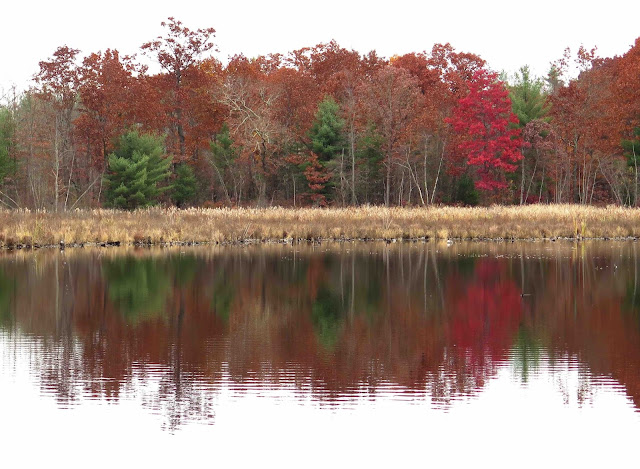Wednesday was gray, but it didn't rain, and the temperature was quite balmy. A nice day for a walk, but I let most of it slip away before I got out of the house. Luckily, there's a delightful trail just on the other side of town, so I headed over to Bog Meadow Brook Nature Trail to stretch my legs before dinner. This trail (a former railroad bed) runs for about two miles amid forested wetlands, swamp, and open marsh, and despite the abundance of invasive plants like Tartarian Honeysuckle and Phragmites that line much of the trail, plenty of native plants thrive there as well.
Many of the trees and shrubs have lost their leaves by now, but as I enter the trail from the Rte. 29 trailhead, I note that the honeysuckles still hold on to most of theirs. Although they are turning yellow now, the leaves remain green enough to continue photosynthesizing, a key reason this shrub can out-compete most of our native shrubs.
But not all of them! Plenty of Gray Dogwood still thrives along this trail, and this time of year this native shrub easily stands out from all surrounding vegetation because of its startling-pink pedicels that hold its stark-white berries.
By contrast, you really have to search to notice the dun-colored catkins of American Hazelnut that dangle from its hairy twigs.
There are plenty of Poison Sumac trees in the swamp near this end of the trail, and this time of year they are easily distinguished, thanks to their abundant clusters of dangling whitish berries. These berries would be quite attractive to include in fall floral arrangements, but I would not recommend that anyone try to do so. Not that ANY vegetation should be picked in this nature preserve, but especially not the kind that could give you quite an unpleasant rash. But they are quite pretty, viewed from a safe distance. And the birds really thrive on them.
The fluffy seed heads of asters are also quite pretty now, especially when found amid the colorful leaves of Blueberry and Meadowsweet.
I'm always delighted to find the dry seed pods of Canada Lily, for I love how the separating sections of the pods are held together by what looks like delicate stitchery.
This old rotting stump almost looked as if it were afire, covered as it was with flame-yellow masses of the tiny discs of Lemon Drop Fungus.
About a mile in, the trail approaches an area of open marsh, a favorite resting place for many migrating waterfowl. Not today, though, for only a few silent Canada Geese could be found quietly moving amid the cattails on the far side of the open water.
On the opposite side of the trail from the open water, a tussock swamp stretches as far as the eye can see. All these varied wetlands create a rich habitat for many kinds of wildlife, where mammals like deer and beavers and foxes and coyotes thrive, as well as abundant numbers of bird species. Bog Meadow Brook Nature Trail is a favorite haunt of avid birders, especially on early mornings.
But this was late afternoon, and all was calm and quiet.
The autumn foliage is muted now, with the exception of a single oak with startling-red leaves.
The leaves and fruit on this Swamp Rose, however, added their own vivid glow to the scene.
I found many other Winterberry shrubs that were laden with more thickly clustered berries than this one was, but I was particularly drawn to the beauty of these graceful branches leaning over the quiet water. They reminded me of Japanese watercolors.
But I was not happy at all to find these berries, as vividly colorful as they are. For these are the fruits of Autumn Olive, an aggressively invasive shrub. Maybe the already-established invasive honeysuckles growing nearby will help to keep this shrub at bay, but I think I will point it out to Bog Meadow's trail steward and ask him to cut it down. Despite the fact that birds love these fruits, we don't need any more alien species here!



























































